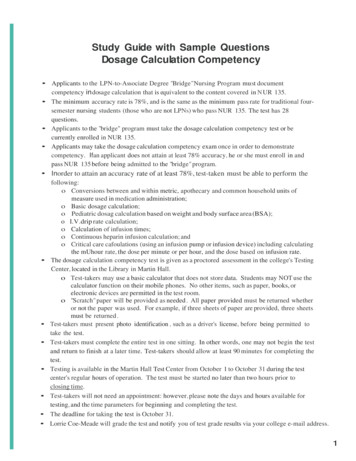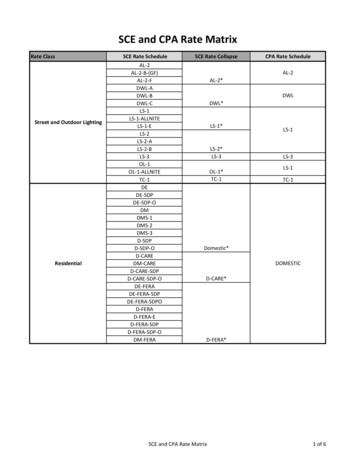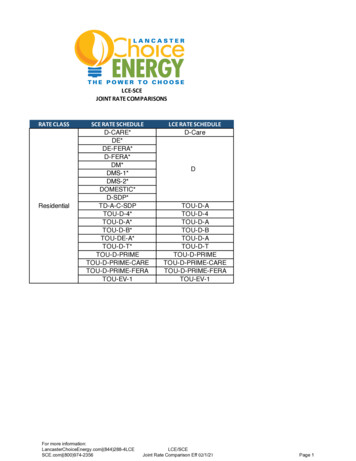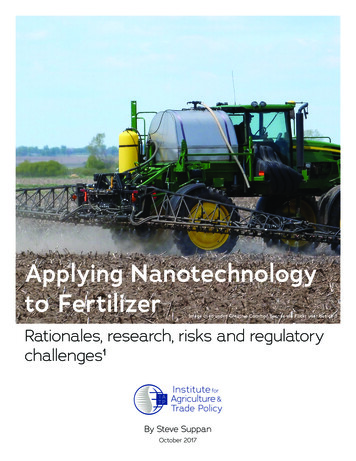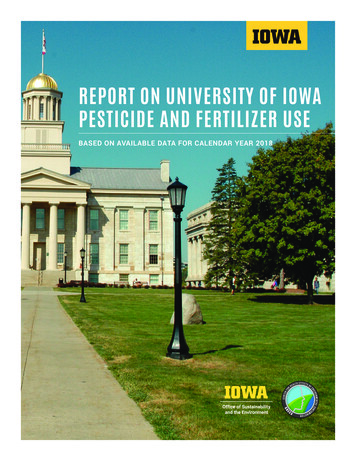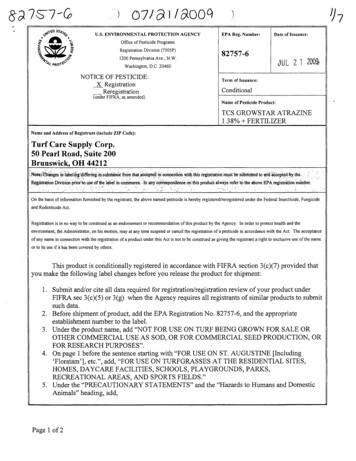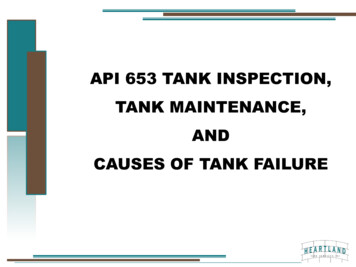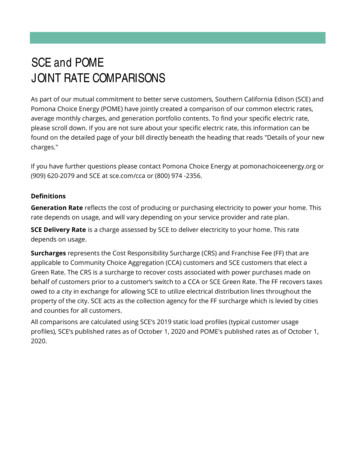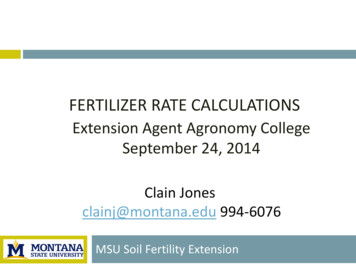
Transcription
FERTILIZER RATE CALCULATIONSExtension Agent Agronomy CollegeSeptember 24, 2014Clain Jonesclainj@montana.edu 994-6076MSU Soil Fertility Extension
Objectives To understand basic concept of yieldresponse curves To take a soil test result and turn it into afertilizer recommendation using publishedrate tables and online tools
Nutrient balanceLiebig-Sprengel Law of theMinimumGrowth is limited by thelimiting factorProper balance leads to Optimal production Best use of fertilizer Protection of water and airIllustration courtesy Government of WesternAustralia Dept. of Agriculture and Food
Soil test indicates probability of responseToxic levelscan reduceyield,nutrient canbe lost towater or airVery high
Limiting soil nutrient levelsNutrientLimiting level in top 6 inches (ppm)NPKCrop and yield goal dependent16250SBClCuFeMnNot available –tissue testing better1.030 lb/ac in top 2 feet0.55.01.0Zn0.5Table 1. Interpretation of Soil Test Reports for Agriculture (MT200702AG)
Fertilizer guidelines Guidelines for N, P, K and 5 micro-nutrients forproduction of most MT crops are provided in FertilizerGuidelines for Montana Crops (EB0161). They are based on soil analysis – discussed earlier. SeeSoil Sampling and Laboratory Selection (MT4449-1), SoilSampling Strategies (MT200803AG). There is not a goodsoil test for S.
FINALLY!!!!How do I determine N fertilizer amount?Basic steps for all crops1. Determine yield potential2. Determine available soil nutrient level – soil test3. Look up suggested nutrient guidelines for given cropand yield in Fertilizer Guidelines for MT Crops or cropspecific bulletins (e.g. pulse, forage)4. Calculate difference between what is available and whatis needed to get fertilizer recommendation
Yield potentialHow determine? Average yield from past records, can be adjusted forsoil moisture in late March, early April Average yield x 1.05 (optimistic or realistic?)
Example N calculationProducer has the following soil test report: Wants to grow malt barley Wheat yield goal 50 bu/ac S wheat yield goal 0.70 x 50 35 bu/ac Barley yield goal 50 bu/ac
Look up N guidelines in Fertilizer Guidelines for MT Crops Barley feed 80 lb N/acBarley malt 66 lb N/acW wheat 130 lb N/ac115 lb N/acS wheat
24 lb/ac61 lb/ac63 lb/actotal85 lb/ac148 lb/ac
What do you suggest and why?What soil N value should you use?24, 61, 63, 85, 148Why?MT Guidelines are based on N in top 2 feetFertilizer N Suggested N – soil test N Barley feed 80 – 85 -5 lb N/ac fertilizer Barley malt 66 – 85 -19 lb N/ac W wheat 130 – 85 45 lb N/ac S wheat 115 – 85 30 lb N/acIs malt barley the best choice?
If 46 lbs per acre of N needed, how much urea(46-0-0) is needed?The 46-0-0 means this fertilizer is 46% N, 0%P2O5, and 0% K2O. So the fraction of N in urea is0.46 (46/100).N fertilizer (46 lbs/acre)0.46 100 lbs urea/acre
N rate adjustments Stubble: small grains stubble is high in carbonto N (C:N). Adjust fertilizer N up or down?10 lb N/1000 lb stubble up to 40 lb N Fallow: assume ½ of stubble has decomposedover previous year when adjusting After legume rotation:Adjust fert up or down?Legumes credit (add) NCropN credit(lb N/acre)Alfalfa40Annual legume 1 x 10Annual legume 3 x 20
N rate adjustments (cont) SOM 1% SOM, add 15-20 lb N/acre 3% SOM, reduce 15-20 lb N/acre Tillage – No-till may require extra N for 6 to 15years
N rate adjustments for remaining stubbleContinuous winter wheatStubble Weight Grain Weight (lb grain/ac) x Stubble/Grain Ratio (lbstubble/lb grain) 3000 lb grain/ac x 1.67 lb stubble/lb grain 5000 lb stubble/acStubble Remaining Stubble Weight (lb stubble/ac) - StubbleRemoved (lb stubble/ac) 5000 lb/acre – 2000 lb/acre 3000 lb/acreNitrogen adjustment for Stubble Remaining 10 lb N/1000 lb Stubblex Stubble Remaining (lb/ac) (add this to N rate, up to 40 lb N/ac) 0.01 lb N/lb x 3000 lb/ac 30 lb N/acThese examples are in Developing Fertilizer Recommendations for Ag
N adjustments for remaining stubble: Fallow-barleyStubble Weight Grain Weight (lb grain/ac) x Stubble/Grain Ratio (lbstubble/lb grain) 4800 lb grain/ac x 1.13 lb stubble/lb grain lb stubble/acStubble Remaining Stubble Weight (lb stubble/ac) - StubbleRemoved (lb stubble/ac) lb/acre – 2000 lb/acre lb/acreNitrogen adjustment for Stubble Remaining 10 lb N/1000 lb Stubblex Stubble Remaining (lb/ac) (add this to N rate, up to 40 lb N/ac) 0.01 lb N/lb x lb/ac lb N/acNitrogen Adjustment for Stubble Decomposition in Crop-FallowSystems 0.5 x Nitrogen adjustment for stubble remaining (lb N/ac) 0.5 x lb N/ac lb N/ac
N adjustments for remaining stubble: Fallow-barleyStubble Weight Grain Weight (lb grain/ac) x Stubble/Grain Ratio (lbstubble/lb grain) 4800 lb grain/ac x 1.13 lb stubble/lb grain 5424 lb stubble/acStubble Remaining Stubble Weight (lb stubble/ac) - StubbleRemoved (lb stubble/ac) 5424 lb/acre – 2000 lb/acre 3424 lb/acreNitrogen adjustment for Stubble Remaining 10 lb N/1000 lb Stubblex Stubble Remaining (lb/ac) (add this to N rate, up to 40 lb N/ac) 0.01 lb N/lb x 3424 lb/ac 34.24 lb N/acNitrogen Adjustment for Stubble Decomposition in Crop-FallowSystems 0.5 x Nitrogen adjustment for stubble remaining (lb N/ac) 0.5 x 34.24 lb N/ac 17.12 lb N/ac
Optimize fertilizer N rateDanger of aggressive N fertilization? Hot dry season, low protein discounts, lower netreturns, and higher leaching/volatilization Nlosses. In wet year if all N is applied early can lead toexcess tiller production and decreased yields. Risk of high forage nitratesStrategy to avoid this possibility? Use a conservative pre-plant N rate Apply a 2nd application if needed – will discuss splitapplications in ‘Timing’ section
Questions on N rate calculations?
P fertilizer calculationsTable 18 (subset). P fertilizer guidelines based on soil analysis (EB0161)Olsen P soil test level (ppm)Crop0481216*P fertilizer rate (lb P2O5 30205Lentil, pea3530252015Wheat - Spring5045353020Wheat - Winter5550454035* With P 16 ppm consider using crop removal rates (EB0161 Table 21) as P fertilizationguideline. P guideline for alfalfa at 16 ppm (0 lb) is likely an error in EB0161.ExampleWinter wheat, Olsen P 10 ppmP2O5 needed 42.5 lb/ac
Rates based on different approachesExample banded P fertilizer recommendations using different approaches.WWheat grain yield potential 60 bu/acreProducer leaves straw on fieldCritical test level for P is approximately 16-18 ppm for all cropsRecommended P rate (lb P2O5/acre)Olsen P 4 ppmOlsen P 20 ppm500Sufficiency approach1.Maintenance approach2. crop removalBuild approach sufficiency maintenance1.Your turnTable 18 in Fertilizer Guidelines for Montana Crops2. Table 21 in Fertilizer Guidelines for Montana Crops
To calculate ‘maintenance or build’ rates, needcrop removal rates Table 21 in EB0161 IPNI nutrient removal calculator: crop nutrientremoval estimates for a broad, andcontinually expanding, list of field cropshttp://ipni.info/calculator
Rates based on different approachesExample banded P fertilizer recommendations using different approaches.WWheat grain yield potential 60 bu/acreExpected straw removal 1.5 ton/acreCritical test level for P is approximately 16-18 ppm for all cropsRecommended P rate (lb P2O5/acre)1. Sufficiency approach2. Maintenance approach crop removalBuild approach 1 2Olsen P 4 ppmOlsen P 20 ppm50060 bu x 0.62 lb P2O5/bu 3787
Why might you recommend a maintenanceapproach? Why would you recommend a buildapproach?
How much MAP (11-52-0) do you need to get43 lb P2O5/ac?The 52 means MAP is 52% P2O5 so fraction is 0.52MAP 43 lb P2O5/ac0.52MAP needed 85 lb/ac
PotassiumTable 19. K fertilizer guidelines based on soil analysis (EB0161)K soil test level (ppm)crop050100150200250*K fertilizer rate (lb K2O /acre)Alfalfa2402051701409530Barley – malt908065503525Grass807060453015Lentil, pea454035302520Wheat13511590704010* With K 250 ppm consider using crop removal rates as K fertilization guidelineExampleMalt barley, K 100 ppm, K2O needed ? lb/ac65
MSU Soil fertility ltest/
S fertilization Tissue sampling more reliable than soil test. 0.20 to 0.25% S in uppermost leaves beforeheading, may limit yield and protein.May be needed if plants appear N deficient,necessary for N utilizationIn-season rescue treatment of 20-30 lb S/acre assulfate can help
Questions so far?
Optimize fertilizer N rate based on economicsHow? Use a conservative pre-plant N rate based on: spring soil sample realistic yield potential economic rate tility/small%20grains%20economic%20calculator.html Apply a 2nd application if needed – based on adjustedyield potential, consider using in-season sensorbased technology
Montana State University Extension
Questions?
Considerations when fertilizing with manureEasy to over apply N, P, and K Rapid excess buildup of P and K if fertilizing tomeet N needs Of 67 Midwest gardens 92% had excess P and 88%excess K after just 1 - 6 years of ‘uninformed’fertilization with composted dairy manure(Hansen unpub data, Ohio State Univ) Feed to P and K demands Use legumes or source such as blood meal tosupply N
Approximately how much total N, P, and K does1” of manure compost supply?N1.2.Removedannually byvegetablesAdded by 1”manureAdded by 1”manureResponseCounterP2O5K2 Olbs/1000 sq. ft.3.40.33.240154061650%50%
Approximately how much total N, P, and K does1” of manure compost supply?NRemovedannually byvegetablesAdded by 1”manureAdded by 1”manureP 2O5K2Olbs/1000 sq. ft.3.40.33.2401540616
How much organic matter? 1” manure compost will add about 1.5% O.M. 1” plant compost will add about 3% O.M. 5-8% O.M. is optimal – O.M. is not the cure-allfor all soil ailments
How can you increase soil organic matterwithout adding too much P and K? Add organic matter high in C (dry leaves,wood shavings, straw, peatmoss), butremember, “immobilization” happens Add organic matter based on plant’s P needsand add N with chemical fertilizer, organicfertilizer such as blood meal, or plant legumes
Summary Fertilizer rates depend on crop, yield goaland soil test values Rates for N need to be adjusted forstubble, prior crop/fallow, SOM, no-till Rates vary for sufficiency, maintenance, orbuild approach to fertilization Piling it on higher and deeper is not theanswer for manure in gardens
Questions?For more information see MSU lfertility/publications.html Developing Fertilizer Recommendations for Ag (MT200703AG) Home Garden Soil Testing & Fertilizer Guidelines(MT00705AG) MT Cool Season Pulse Production Guide (EB0210) Nitrate Toxicity of MT Forages (MT200205AG) – revision this fall Soil Nutrient Management for Forages: P, K, S and Micros(EB0217) Soil Nutrient Management for Forages: N (EB0218)
WWheat grain yield potential 60 bu/acre Producer leaves straw on field Critical test level for P is approximately 16-18 ppm for all crops Recommended P rate (lb P 2 O 5 /acre) Olsen P 4 ppm Olsen P 20 ppm Sufficiency approach1. 50 0 Maintenance a

